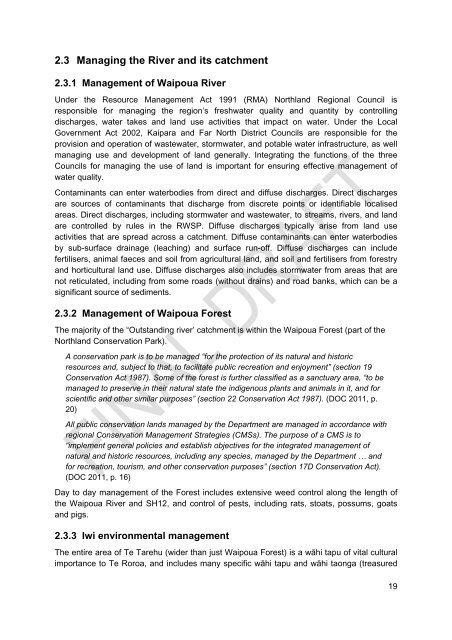Waipoua River 20130219.pdf - Northland Regional Council
Waipoua River 20130219.pdf - Northland Regional Council
Waipoua River 20130219.pdf - Northland Regional Council
- No tags were found...
Create successful ePaper yourself
Turn your PDF publications into a flip-book with our unique Google optimized e-Paper software.
2.3 Managing the <strong>River</strong> and its catchment2.3.1 Management of <strong>Waipoua</strong> <strong>River</strong>Under the Resource Management Act 1991 (RMA) <strong>Northland</strong> <strong>Regional</strong> <strong>Council</strong> isresponsible for managing the region’s freshwater quality and quantity by controllingdischarges, water takes and land use activities that impact on water. Under the LocalGovernment Act 2002, Kaipara and Far North District <strong>Council</strong>s are responsible for theprovision and operation of wastewater, stormwater, and potable water infrastructure, as wellmanaging use and development of land generally. Integrating the functions of the three<strong>Council</strong>s for managing the use of land is important for ensuring effective management ofwater quality.Contaminants can enter waterbodies from direct and diffuse discharges. Direct dischargesare sources of contaminants that discharge from discrete points or identifiable localisedareas. Direct discharges, including stormwater and wastewater, to streams, rivers, and landare controlled by rules in the RWSP. Diffuse discharges typically arise from land useactivities that are spread across a catchment. Diffuse contaminants can enter waterbodiesby sub-surface drainage (leaching) and surface run-off. Diffuse discharges can includefertilisers, animal faeces and soil from agricultural land, and soil and fertilisers from forestryand horticultural land use. Diffuse discharges also includes stormwater from areas that arenot reticulated, including from some roads (without drains) and road banks, which can be asignificant source of sediments.2.3.2 Management of <strong>Waipoua</strong> ForestThe majority of the “Outstanding river’ catchment is within the <strong>Waipoua</strong> Forest (part of the<strong>Northland</strong> Conservation Park).A conservation park is to be managed “for the protection of its natural and historicresources and, subject to that, to facilitate public recreation and enjoyment” (section 19Conservation Act 1987). Some of the forest is further classified as a sanctuary area, “to bemanaged to preserve in their natural state the indigenous plants and animals in it, and forscientific and other similar purposes” (section 22 Conservation Act 1987). (DOC 2011, p.20)All public conservation lands managed by the Department are managed in accordance withregional Conservation Management Strategies (CMSs). The purpose of a CMS is to“implement general policies and establish objectives for the integrated management ofnatural and historic resources, including any species, managed by the Department … andfor recreation, tourism, and other conservation purposes” (section 17D Conservation Act).(DOC 2011, p. 16)Day to day management of the Forest includes extensive weed control along the length ofthe <strong>Waipoua</strong> <strong>River</strong> and SH12, and control of pests, including rats, stoats, possums, goatsand pigs.2.3.3 Iwi environmental managementThe entire area of Te Tarehu (wider than just <strong>Waipoua</strong> Forest) is a wāhi tapu of vital culturalimportance to Te Roroa, and includes many specific wāhi tapu and wāhi taonga (treasured19
















